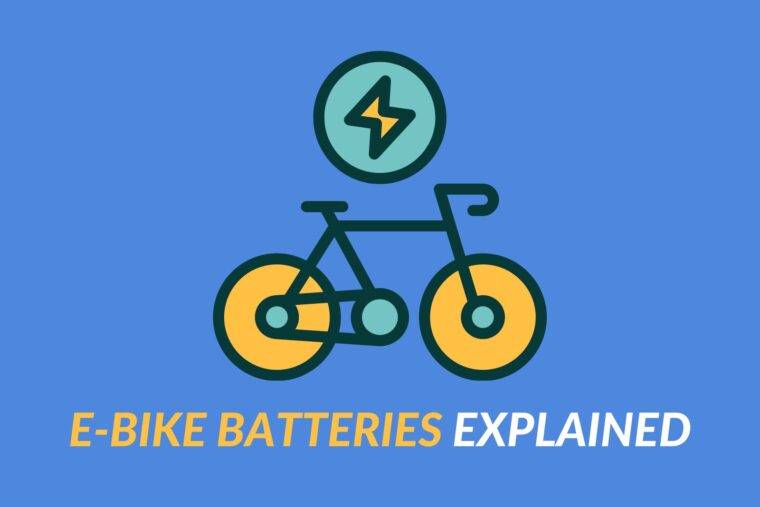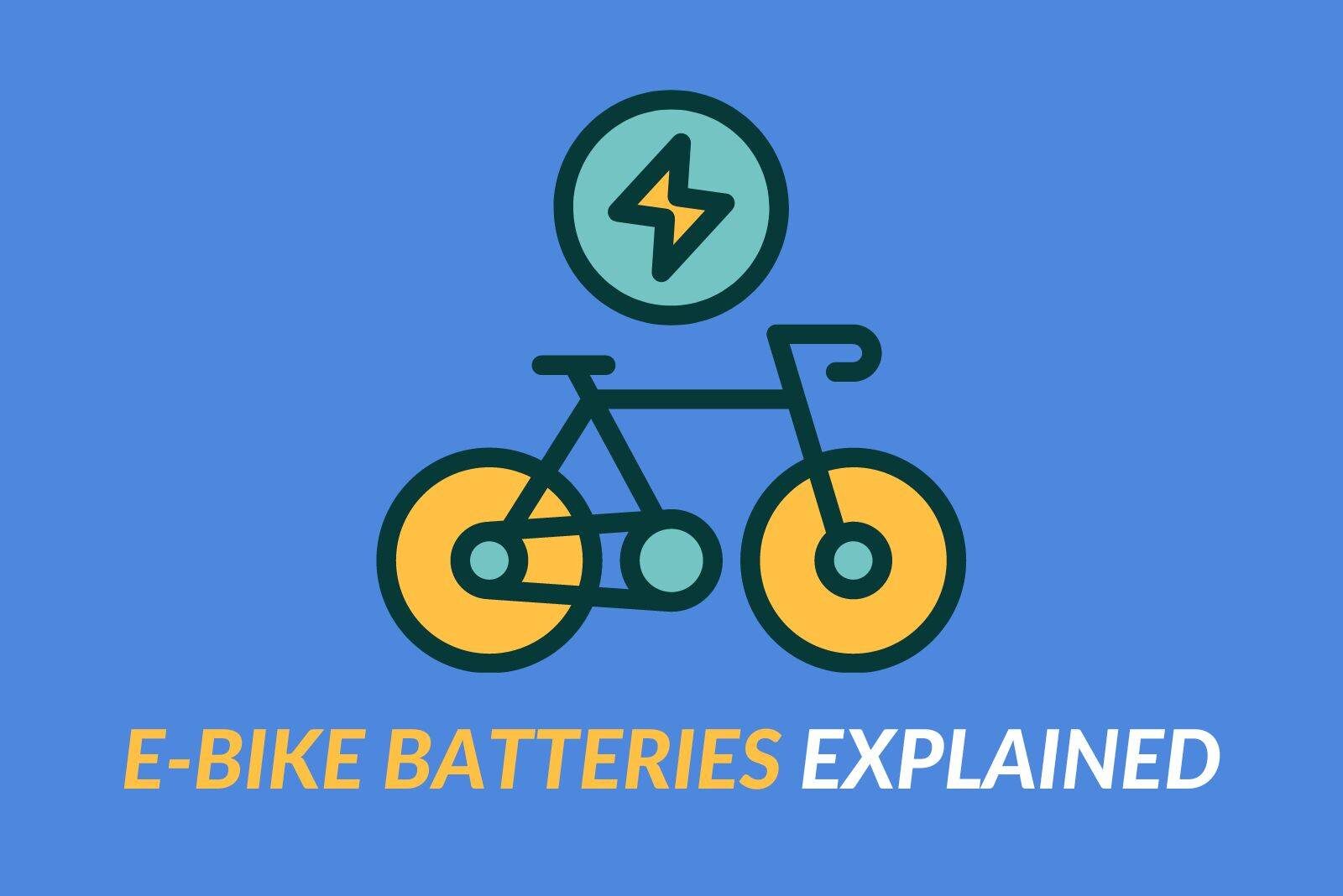
Electric bikes, or e-bikes, are now established in the commuting world and can be regularly seen on our streets. If you are a newcomer to cycling or more experienced, the chances are you will have been tempted by pedalling with electrical assistance.
In the UK, sales of electric bikes have maintained a steady growth since 2020. The Bicycle Association, the national trade body for the UK cycle industry, predicts the e-bike share of total bike sales will triple by the end of 2023.
Electric bikes are manufactured both by legacy companies and specialist providers. You can search for e-bikes alongside analogue bikes at most of the well known retailers like Trek, Giant, Raleigh and Specialized or look into the independent electric bike brands like Rad Power, Cowboy, or VanMoof.
The essence of cycling is unchanged by the advent of electrically powered pedal assistance. You’re still outdoors and exercising. You don’t need a special licence if these ‘electrically assisted pedal cycles’ (EAPCs) are still recognised as pedal cycles. The basic geometry of the bike is unchanged by the technology, although most e-bikes are a little heavier.
You can explore all the roads and trails including some which might have been out of reach. But even if you want to just go to and from work, as a discerning cyclist you can rely on the battery and electric motor combination to sweep you to your destination with effortless ease.
Electric bike batteries are perhaps the most important component of an e-bike. They facilitate the flow of a current to the bike’s motor which provides the power for pedal assistance.
E-bike batteries hold charge which drains from the battery to the motor as it is used. The intensity of the battery use depends on the intensity of motor use. You will use more of the battery’s charge if you ride with more cargo, or need it for every time the road goes uphill.
Most electric bike batteries are portable and simple to recharge. They plug into conventional wall sockets just like your wearables or laptop. Some don’t detach so you’ll plug the whole bike into the wall. Like all components, they are subject to wear and have a lifespan.
Eventually, you’ll need to replace your e-bike battery.
Electric bike battery replacement is straightforward in most cases. Provided the manufacturer still makes the same model it’s a simple swap. But with some estimates of electric bike battery replacement cost being at least one-third of the value of the bike, it can be an expensive purchase.
Let’s have a look at like-for-like electric bike battery replacement and cheaper options available, as well as refurbishment, recycling and a guide to what you can do to delay each swap.
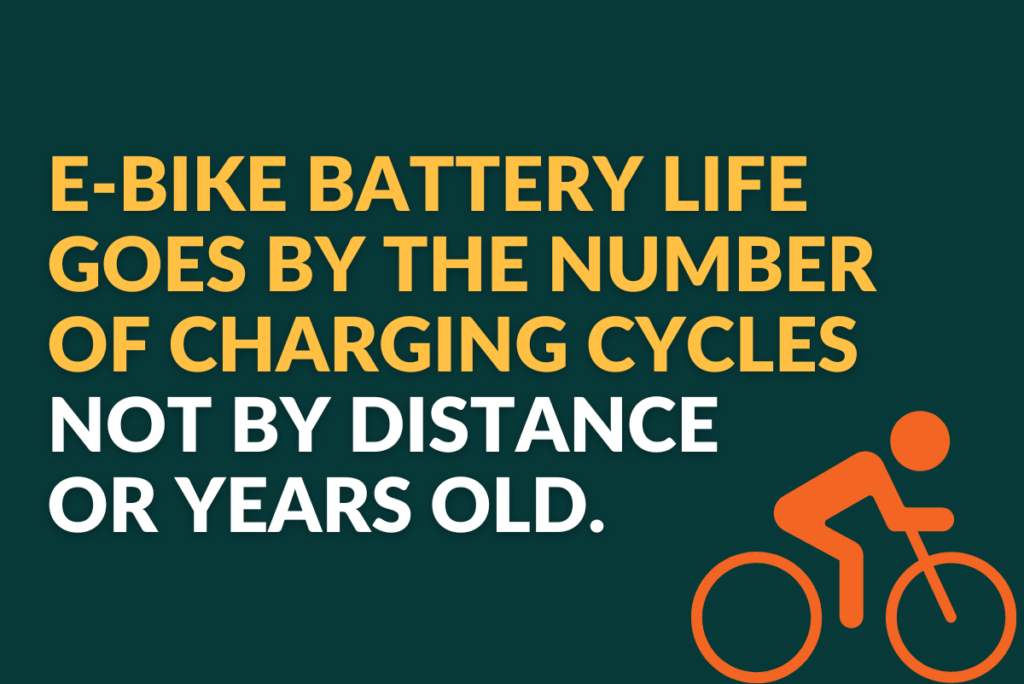
Electric Bike Battery Lifespan
E-bike battery life is measured by the total number of charging cycles of the battery you get and not by distance or years. This is because no two riders have the same requirements from their battery. You’ll hear manufacturers like Bosch, Yamaha and Darfon talking about charging cycles.
If you buy an e-bike, most of the trusted brands use lithium-ion (Li-ion) batteries. Just like the ones in a phone or a Tesla. Cheap new electric bike batteries will be lead-acid or nickel-acid batteries. Think car batteries. Li-ion batteries are more efficient and last longer than lead-acid batteries. Li-ion versions perform better under stress than lead-acid versions.
Regardless of how little you rely on your electric bike battery, it will still have a ‘natural’ life span. It will still lose performance and efficiency over time. How you charge it and store it all influence this shelf life and we’ll look into that too.
Even when dormant, the organised line-up within a battery (grouped together and called cells) react with each other and expend some of their performance. This is called self-discharging.
How Long Do Electric Bike Batteries Last?
It should be a minimum of two years before the average rider needs to look for a replacement electric bike battery. Manufacturers publish in numbers of charging cycles. It’s worth repeating that we all have different requirements for an e-bike, so we can’t be certain how long a battery will last.
Legacy bike manufacturers and niche specialists also refer to frequency of charging cycles to determine how long a battery will last. Once the number of charges is known, Rad Power gives an average of two-and-a-half years for a frequent rider and a minimum of six years for a casual rider.
One charging cycle takes the battery from its discharged state (0%) up to a full charge (100%). 30% to 80% is a half-charge and 35% to 60% is a quarter-charge and so on. The higher quality battery will generate more full charge cycles. Bosch includes a Battery Management System (BMS), which monitors the performance of the individual cells to prolong battery life.
The time between charging cycles is determined by how often the battery is asked to do its work and under what circumstances. If it’s always on and under duress, for example riding up steep gradients, you’ll be recharging more quickly than if you only use it once on each ride to get over a road bridge.
It’s a similar story with range. If you use a smaller battery constantly for long commutes of 40km each way, expect to charge each evening, if not more often. If you use it only for a long, quiet stretch of 5 kilometres on flat roads, you won’t be charging as frequently as that.
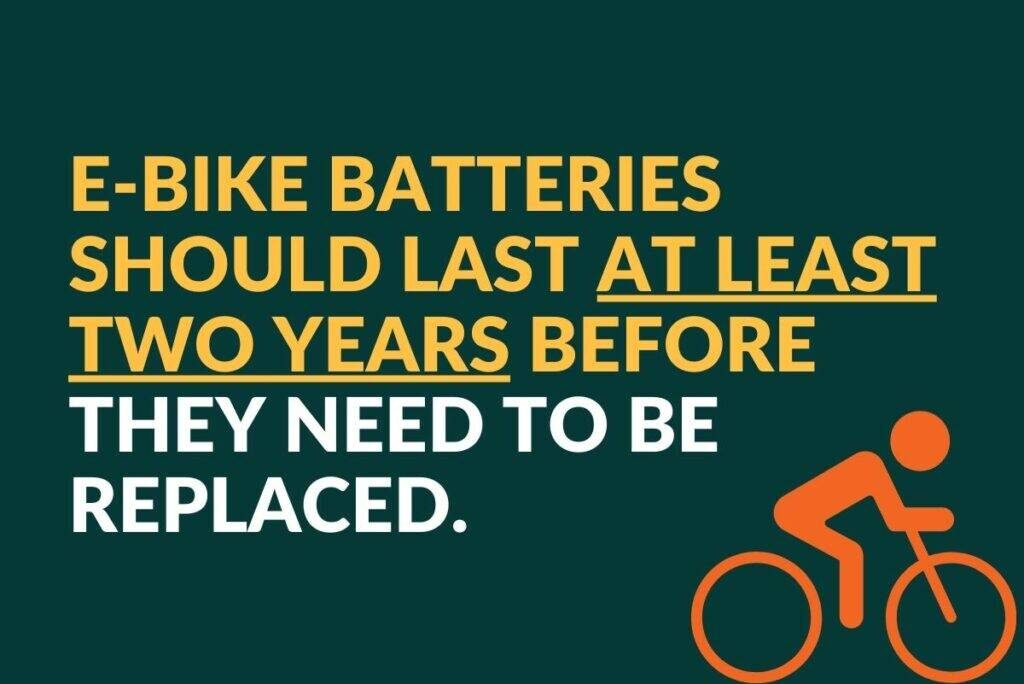
Stages of Electric Battery Life
An e-bike battery should gradually lose performance over time. The rate at which performance suffers will increase as you move closer to end of life.
General day-to-day issues with performance – diminished range, the bike stuttering under load, or temporary cut-outs of power – are not necessarily symptoms of a soon-to-be-expired battery. The battery may just need charging.
We’ll talk below about the perfect environment to run and maintain a battery. But assuming you do this, at least the first 300 charge cycles of all battery types should see it operating at peak capacity and performance.
Nickel and lead battery performance will diminish after this point, sooner for lead. Li-ion will continue to go on strong before it hits a threshold at around 500 cycles. It’s thought that lithium-ion ebike batteries are good for up to 1,000 charge cycles in total though. Cheap electric bike batteries will need replacing sooner than the more expensive Li-ion versions.
As your battery reaches a threshold, it is going to perform at less than 100% of its maximum capacity. Somewhere like 80% of maximum capacity is expected. This just keeps going down over time. My 18-month-old smartphone battery is currently running at 83% of its maximum capacity and I don’t notice any drop in performance.
It will be the same for the next couple of hundred e-bike battery charge cycles; you won’t notice any diminished battery performance. However, over time, you’ll eventually have to increase the rate of charge cycles or adapt your riding if you want to charge less often.
You will find the day-to-day problems happen more frequently and decision day on a replacement will come around sooner.
When to Replace Electric Bike Battery?
Eventually, your e-bike battery will provide you with symptoms at the end of useful life. It might start making strange sounds, or overheat in normal conditions, discharge more quickly or take longer to charge up. Remember your warranty if you think something may be faulty. Two years is standard.
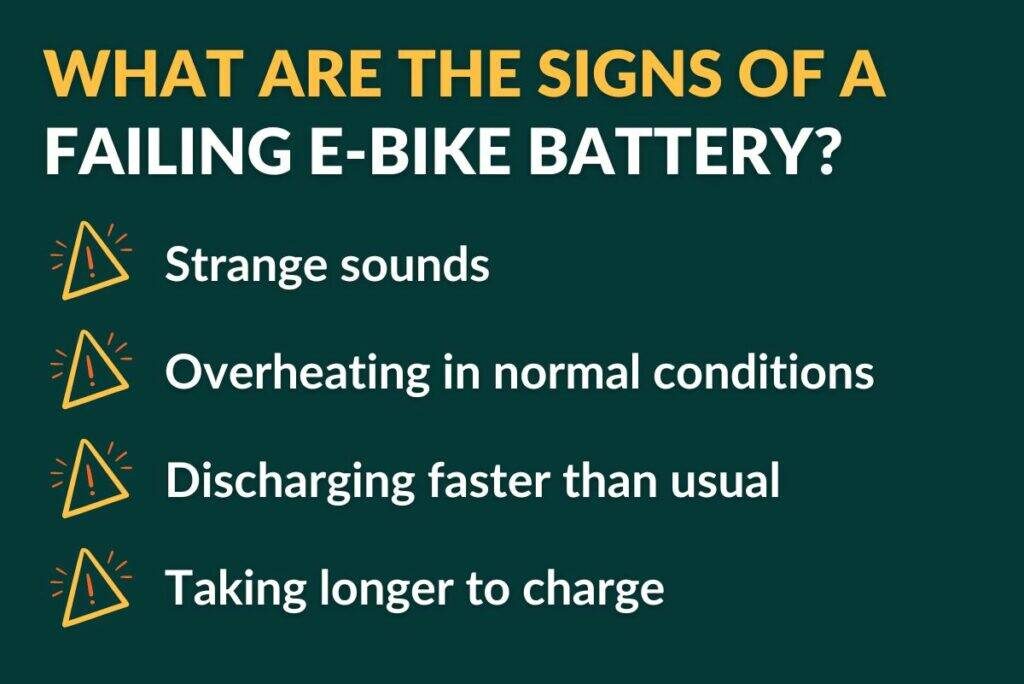
How Do I Know if My E-Bike Battery is Healthy?
You’ll know because the performance of the bike is within the manufacturer’s tolerances. The charge cycle will take the amount of time it says it should. The range is as you expect for the conditions you are riding under. When needed, the battery will keep providing smooth power under duress.
How Often Do Electric Bike Batteries Need Replacing?
Bike batteries need replacing after a minimum of 500 charge cycles if you have bought a cheap lead or nickel acid battery. A lithium-ion battery will see you reach 1,000 charge cycles before considering a replacement. How intensely you use your e-bike determines how often you deploy a charge cycle.
The intensity of use is a personal or professional choice. For example, a cycle courier uses a bike as a tool of the trade and relies on speed and consistent power to schedule jobs. They may want a longer range for all day use or a larger motor in case of fatigue. They might charge every day or more frequently.
Someone new to cycling who wants the reassurance of a pedal-assisted power on a long day out for five or ten minute bursts of one 30 minute ride a day might only need to charge three times a week. A daily commuter who has a couple of hills to get over might need less.
The power generated by the motor is a very important consideration in charge cycle frequency too. E-bike motor power is a selling point and top speeds can be eye-watering. If you want to travel up to 40mph and with a throttle you can.
It’s imperative that you check your state, or country’s classification of e-bikes before you choose your motor size and before you go out on the roads. Some of these motors change the classification of an e-bike to a motorbike. With all of the insurance, licensing and safety regulations that owning a motorbike entails.
E-Bike Battery Replacement
The most straightforward option is to replace the battery on a like-for-like basis. Pay a visit to the retailer where you bought the bike and hey presto!
Designers of e-bike batteries continue to work on weight and housing of the unit as areas of improvement and innovation. Commonly seen on the downtube of the frame, they have moved to a rear rack, or integrated / enclosed within the frame.
Making batteries lighter and more aerodynamic certainly improves the weight and aesthetics of an e-bike but can restrict the choices available. Rear-rack mounted batteries are common in Europe and replacements are easier to find than the frame-enclosed types. This frame-enclosed version requires the expertise of your local bike shop to inspect.
Battery manufacturers should keep a supply of your battery type in stock because they know the shelf-life. They’ll balance their inventory and should look to offer more advanced batteries with new tech that still slots into your charger and bike frame.
This will most likely be your most expensive option. But could you consider replacing it via a different source? What about recycling and sustainability? After all, electric cycling promotes environmental good deeds. And then how do you dispose of your old battery safely?
Can You Upgrade an E-Bike Battery?
You might be unhappy with the range provided by your e-bike battery or the rate at which it can feed power to the motor. Therefore you might consider upgrading. The voltage of the upgraded battery must be compatible with the motor and controller of your e-bike.
Check with the manufacturer before you consider an upgrade. Remember that your warranty may expire the moment that you make an upgrade. You should only replace with kit from the same manufacturer. Non-original replacements could create serious risks and hazards to you and other users.
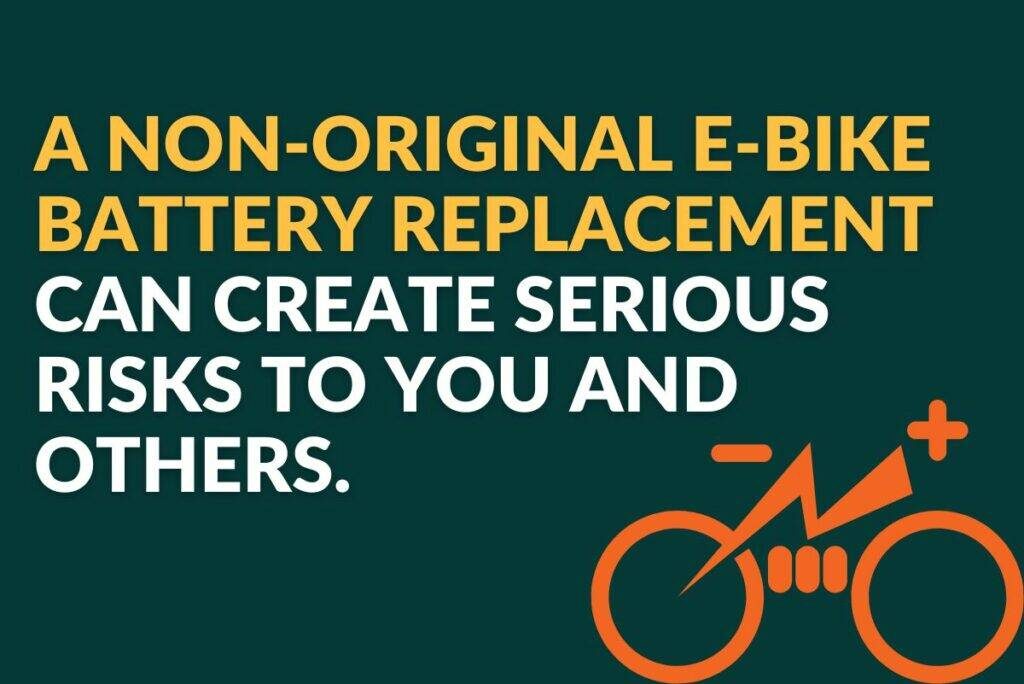
Branded battery manufacturer Bosch offers a frame-mounted PowerPack 300, 400 and 500 model to replace your outgoing PowerPack. The number reflects the expected number of Watt Hours (Wh) delivered by the battery. The rate of the electrical current through to the motor increases as you move through these models.
Shimano Steps offers a similar selection of increased performance through its range. As does Specialized. Battery manufacturers tend to offer a full package deal – motor, handlebar controller and battery. As such, they can easily integrate tech throughout their systems.
Upgrades to firmware are now carried out via Bluetooth and you should check if upgrading the battery loses synch with these systems. The progress of this technology might hamper backwards compatibility with older battery systems.
Many specific e-bike only manufacturers use unbranded batteries but with trusted cells inside. Rad Power uses Samsung 35E cells. TENWAYS uses Samsung, LG or Panasonic cells.
Where to Buy Replacement Electric Bike Battery?
The first place would be from your e-bike retailer. As well as like-for-like swaps their FAQs might have upgrades or replacements for older models. Some push you to the battery manufacturer. Most of the specialist sites which offer replacements for non-branded batteries have compatibility charts so you can check what options are available to you.
Listed e-bike battery manufacturers are Bosch, Shimano, Brose, Yamaha, Suntour, TransX, Fazua, LiGo, Cytronex and Pedego.
Then you can look at eBay, Amazon, forums and other sites. But you will be carrying some risk if you don’t investigate compatibility and compliance fully.
As you might expect of an electric product, you should check that any battery you buy meets regulatory standards. For example: BS EN 50604-1, UN38.3 and IEC.EN62133, UL 2849. Charging and storing e-bike batteries comes with a fire safety risk. Catastrophic failure can lead to explosions.
Where to Buy Cheap Electric Bike Batteries?
| Retailer that you bought the e-bike from |
| Branded battery manufacturer |
| eBay, reselling sites and forums |
| Amazon |
| Recelling and specialists in unbranded e-bike battery refurbishment |
| Bike manufacturer |
Amazon offers an abundance of unbranded ebike replacement batteries which are cheap. There are thousands on offer for less than £300 / $ 355, which is usually the base price for branded models. You could look at reselling sites like eBay for part used branded batteries. But ask lots of questions. Rear rack models are the most popular type of cheap electric battery.
E-Bike Battery Refurbishment
Branded e-bike battery manufacturers are clear. Their models should not be refurbished. There’s a lot of science going on inside the case that they don’t want you to risk looking at. There are plenty of recognised international safety standards they comply with that you don’t.
Some recelling companies don’t work on batteries of certain branded battery manufacturers either. As we’ve discussed further up the thread, certain original unbranded batteries can be upgraded and refurbished by improving the quality of the individual cells inside the pack.
Can Electric Bike Batteries Be Refurbished or Rebuilt?
If you don’t have a branded battery, refurbishment is possible by improving the quality of the technology inside the battery case. This is NOT a DIY job for you. But there is a cottage industry only a few clicks away which can offer to upgrade the brains of your battery.
Recelling will swap out the older individual cells for new ones and snap them back inside the original case. This might boost the performance you had achieved with the older cells.
Once again, check carefully before going down this path. The warranty of your bike will almost certainly be voided by refurbishing your battery.
Upgrades to the BMS board are offered by recelling companies too. So you can boost the performance of a non-branded battery and some branded batteries. You must check that all of the other components on the bike can cope with the upgrades. Frames and wheels should be OK, but brake performance should be closely reviewed.
Where to Refurbish E-Bike Battery
In the UK, the aptly named Electric Bike Battery Repairs offers a recelling service. In the US, you could look at E-Bike Marketplace or FTH Power. Cells which go by the title 18650 are listed as being of higher quality than many of the cells installed in original unbranded batteries.
You should also look to the original e-bike battery manufacturer for refurbishing options.
Electric Bike Battery Repairs
If you think your e-bike battery is faulty, contact your manufacturer. Don’t try to fix it at home. Raleigh gives some good advice on potential battery failure here.
The market leaders in the branded bike batteries say faulty, old or ‘worn out’ batteries should not be repaired. They cite safety concerns.
As we’ve highlighted with the upgrade options above, there are many online options for battery repair you could consider. Some of these include battery testing options first and some give a warranty.
What Can I Do with Old E-Bike Batteries?
E-bike batteries should be disposed of carefully and not tossed into regular bins. Branded e-bike battery manufacturers talk about checking with local authorities or returning it to your bike dealer. There are recognised recycling facilities in the USA and the UK has joined the recycling revolution.
People for Bikes in the USA recognises a scheme called Call2Recycle. Retailers in the UK via the collective body The Bicycle Association is setting up a battery collection and recycling function. It has partnered with the European Recycling Platform.
The European e-bike marketplace is much more mature than in the UK. For example, in 2018 over half all adult bikes sold in the Netherlands were electric. As a result, the number of batteries reaching the end of their serviceable life is significantly greater.
In Sweden and Norway, two companies have joined forces to recycle batteries and hopes to process Norway’s entire annual requirement.
A quick chat with your local bike shop or view of the local authority’s recycling programme will be your best guide.
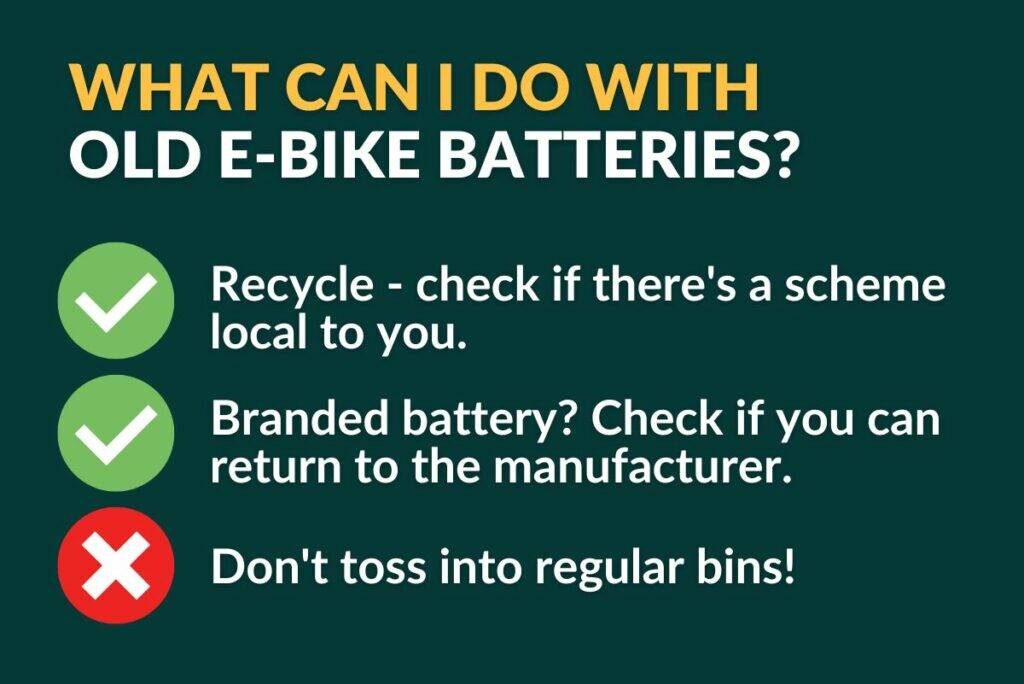
E-Bike Battery Care Guide
You can take some really simple steps and get into good habits to prolong the life of your e-bike battery. Some of them are daily jobs and some part of a longer term regime. Most of these won’t break the bank.
- Cleaning – use a damp cloth
- Storage temperature – avoid extreme temperatures (keep at between 0°C – 20°C) and be especially careful in winter – bring the battery indoors
- Store in the dry and don’t charge a wet battery
- Park bike in the shade
- Remove the battery when transporting the bike – avoids damage by bad weather and road debris
- Keep some charge at all times – especially during prolonged storage – between 30% and 60% is recommended
- Invest in an automatic charger with cut-off
- Avoid constant overloading of the battery – lighten the load if you can
- Never use a charger which did not come with your battery
- Never overcharge
- Keep the discharge contacts clean and grease them very occasionally
- Clean the battery separately and carefully, avoid splashing water on the contacts and avoid power washing
The post Electric Bike Battery Replacement: 6 Places to Find Cheap E-Bike Batteries appeared first on Discerning Cyclist.
